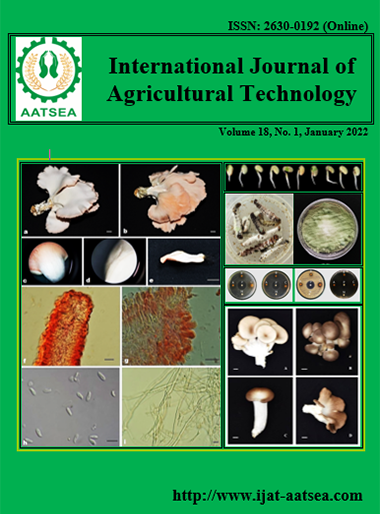Adulticidal activity against housefly (Musca domestica L.; Muscidae: Diptera) of eucalyptol, limonene, and their combined formulation
Main Article Content
Abstract
The insecticidal potency of eucalyptol, limonene, and a combined formulation against housefly (Musca domestica) was evaluated and compared to that of cypermethrin, a common synthetic insecticide. The knockdown and mortality rates were determined by a standard susceptibility assay recommended by World Health Organization. The tested concentrations of eucalyptol and limonene were 1, 5, and 10%, while the combined formulation was 5% eucalyptol + 5% limonene. The highest efficacy (100% mortality rate) was provided by the combined formulation (5% eucalyptol + 5% limonene). Both individual essential oil constituents provided a mortality rate ranging from 10.7-82.0% and a knockdown rate ranging from 8.0-81.3%. Most importantly, the 5% eucalyptol + 5% limonene combined formulation provided as high a mortality and knockdown rate as that of 10% cypermethrin. Therefore, it has a good potential as a safer and equivalently effective, natural product alternative to cypermethrin.
Article Details

This work is licensed under a Creative Commons Attribution-NonCommercial-NoDerivatives 4.0 International License.
References
Chantawee, A. and Soonwera, M. (2018). Larvicidal, pupicidal and oviposition deterrent activities of essential oils from Umbelliferae plants against house fly Musca domestica. Asian Pacific Journal of Tropical Medicine, 11:621-629.
Chauhan, N., Malik, A. and Sharma, S. (2018). Repellency potential of essential oils against housefly, Musca domestica L. Environmental Science and Pollution Research, 25:4707-4714.
Freeman, J. C., Ross, D. H. and Scott, J. G. (2019). Insecticide resistance monitoring of house fly populations from the United States. Pesticide Biochemistry and Physiology, 158:61-68.
Iqbal, W., Malik, M. F., Sarwar, M. K., Azam, I., Iram, N. and Rashda, A. (2014). Role of housefly (Musca domestica, Diptera; Muscidae) as a disease vector; a review. Journal of Entomology and Zoology Studies, 2:159-163.
Kanjanapusit, S. (2021). Strict control of lumpy skin disease in cattle. Thailand’s Department of Livestock Development. Retrieved from https://dld.go.th/th/index.php/th/newsflash/341-news- /23707-hotiss ue-25640407-1.
Khamesipour, F., Lankarani, K. B., Honarvar, B. and Kwenti, T. E. (2018). A systematic review of human pathogens carried by the housefly (Musca domestica L.). BMC Public Health, 18:1049.
Khan, H. A. A., Akram, A. and Fatima, A. (2017). Resistance to pyrethroid insecticides in house flies, Musca domestica L., (Diptera: Muscidae) collected from urban areas in Punjab, Pakistan. Parasitology Research, 116:3381-3385.
Kumar, P., Mishra, S., Malik, A. and Satya, S. (2013) Housefly (Musca domestica L.) control potential of Cymbopogon citratus Stapf. (Poales: Poaceae) essential oil and monoterpenes (citral and 1,8-cineole). Parasitology Research, 112:69-76.
Kumar, P., Mishra, S., Malik, A. and Satya, S. (2014) Biocontrol potential of essential oil monoterpenes against housefly, Musca domestica (Diptera: Muscidae). Ecotoxicology and Environmental Safety, 100:1-6.
Scalerandi, E., Flores, G. A., Palacio, M., Defagó, M. T., Carpinella, M. C., Valladares, G., Bertoni, A. and Palacios, S. M. (2018). Understanding synergistic toxicity of terpenes as insecticides: contribution of metabolic detoxification in Musca domestica. Frontiers in Plant Science, 9:1579.
Palacios, S. M., Bertoni, A., Rossi, Y., Santander, R. and Urzúa, A. (2009). Efficacy of essential oils from edible plants as insecticides against the house fly, Musca Domestica L. Molecules, 14: 1938-1947.
Sinthusiri, J. and Soonwera, M. (2013). Efficacy of herbal essential oils as insecticides against the housefly, Musca domestica L. The Southeast Asian Journal of Tropical Medicine and Public Health, 44:188-196.
Soonwera, M. and Sittichok, S. (2020). Adulticidal activities of Cymbopogon citratus (Stapf.) and Eucalyptus globulus (Labill.) essential oils and of their synergistic combinations against Aedes aegypti (L.), Aedes albopictus (Skuse), and Musca domestica (L.). Environmental Science and Pollution Research, 27:20201-20214.
Sprygin, A., Pestova, Y., Wallace, D. B., Tuppurainen, E. A. and Kononov, V. (2019). Transmission of lumpy skin disease virus: a short review. Virus Research, 269:1976372.
Sukontason, K. L., Boonchu, N., Sukontason, K. and Choochote, W. (2004). Effects of eucalyptol on house fly (Diptera: Muscidae) and blow fly (Diptera: Calliphoridae). Revista do Instituto de Medicina Tropical de São Paulo, 46:97-101.
Wang, J. N., Hou, J., Wu, Y. Y., Guo, S., Liu, Q. M., Li, T. Q. and Gong, Z. Y. (2019). Resistance of house fly, Musca domestica L. (Diptera: Muscidae), to five insecticides in Zhejiang province, China: the situation in 2017. Canadian Journal of Infectious Diseases and Medical Microbiology, 2019:4851914-4851914.
World Health Organization (WHO) (2018). Test procedures for insecticide resistance monitoring in malaria vector mosquitoes – 2nd ed. Geneva: World Health Organization. Retrieved from https://apps.who.int/iris/bitstream/handle/10665/250677/9789241511575eng.pdf.


